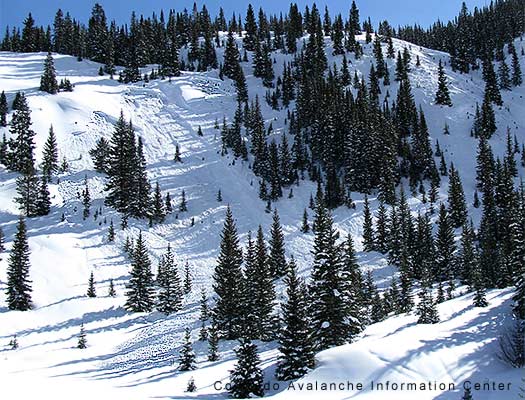Backcountry avalanche terrain in this area of Colorado has been incredibly dangerous. Even before recent storms dropped several feet of snow in places, the snowpack was so unstable that people were remotely triggering avalanches that ran in odd places, such as through incredibly dense timber from tiny starting zones. These types of lengthy avalanche danger cycles are nothing new to Colorado — or really nearly any region of cold, high altitude mountains. Thin snowpack combined with cold equals recrystalization of the snow; more snow accumulates on top of the weak crystals, and the whole conglomeration ends up sitting there like a time bomb waiting for a fuse.
Sadly, the fuse this past Tuesday was Aspen local John Joseph Kelley, who died in an avalanche near the Lindley Hut.

Photo of Lindley Hut avalanche, courtesy CAIC. A man also died in an avalanche here in 2002. While CAIC wasn't specific about where in the photo victim was buried, we're assuming he was somewhere near the denser trees in the center of the photo. The fracture is obvious in the photo, and actually continues out of my cropped version to the right (see full version on CAIC website via link above). Bear in mind that this slide only ran a paltry 200 vertical feet -- but moved a lot of snow. Reports say some of the debris probed at six feet deep
This tragedy brings a few things to mind. Yes, it’s easy to focus on the fact that Kelley wasn’t wearing a beacon and his companions couldn’t do a companion rescue. But look beyond that obvious lesson (according to reports, significant trauma was a factor, so as always the beacon was a last resort anyway). Following is some of the schooling myself and friends got over the past weeks. Yep, always learning.
After we remotely triggered an alarming and deadly avalanche a few weeks ago (we were on a ridge, following a safe route), it was obvious that we had an exceptionally dangerous situation in this region. After realizing the reality of our dire snowpack, the first thing that came to our minds is that we had to ramp up our level of caution to levels that can look ridiculous and are hard to sustain. As a result, we subsequently skied some very conservative terrain that day, to the point of not getting in much in the way of turns — but adhering to the mindset that we were out on a “tour,” and we’d just enjoy ourselves no matter what. But a few days later we still had another close call.
We were in the same area, skiing super conservatively, but the approach to one of our favorite zones crosses the runout of a huge avalanche path. The thing only runs once a year or so, but we all commented that the monster looked primed and ready, and thus worthy of caution. So on the way in we crossed one at a time, near the lowest historical run of the path where it only reaches on bigger years.
Then, on the journey back we let our guard down. Due to various circumstances (including the desire to make about four more turns) we ended up a bit higher on the path . We were still in the runout, but in an area that gets hit nearly every time the path slides. We crossed quickly, one at a time, and returned home. Later that day, someone else who was there after we left told me that about 1/2 hour after we crossed, the path ran big and covered our tracks. If the path did slide while you were crossing near the middle, it’s too wide to do a quick exit before getting hit. Whoa. Thirty minutes from one of us possibly getting killed. That to me was too close.
Mistake, we let our guard down because we just couldn’t make the leap to the level of caution that would have taken us lower on the path. In fact, on the return we’d even discussed crossing higher, so as to avoid climbing in and out of a small gully that requires some inconvenient side stepping.
Takehome: The craft of avalanche safety requires much thinking and acting outside your day-to-day routines. It’s easy to learn how to evaluate snowpack safety, especially when you live near or in the areas you ski. But what you do with your evaluation is a whole other story. My advice is to be radical. If you live and play in a mid-continental snowpack (or for that matter, in any snow climate), be willing to dial your expectations and resulting actions back so far you may hardly feel like you’re “skiing,” in the sense of modern climbing for turns. But you’ll stay alive so that when it does get good, and it will, you’ll be there to enjoy it.
We send our condolences to Kelley’s family and friends, and want to reemphasize that a snowpack this tricky is incredibly tough to deal with both intellectually and on a gut level. Thus, any of us could have ended up in Kelley’s situation — beacon or no beacon.
WildSnow.com publisher emeritus and founder Lou (Louis Dawson) has a 50+ years career in climbing, backcountry skiing and ski mountaineering. He was the first person in history to ski down all 54 Colorado 14,000-foot peaks, has authored numerous books about about backcountry skiing, and has skied from the summit of Denali in Alaska, North America’s highest mountain.
